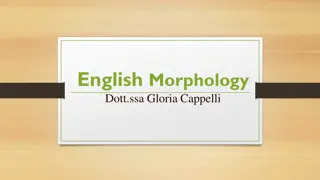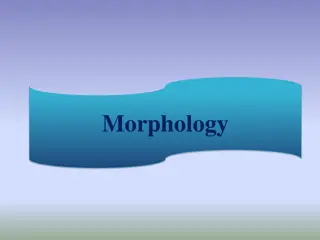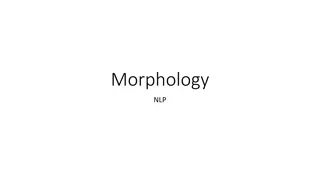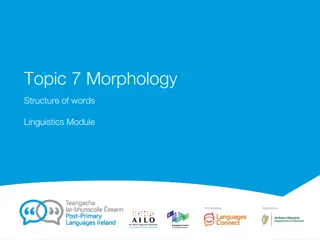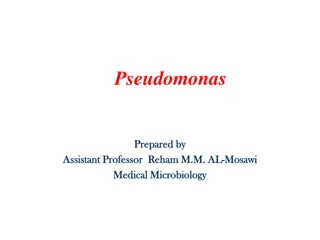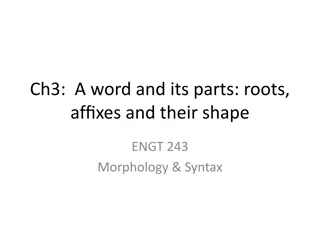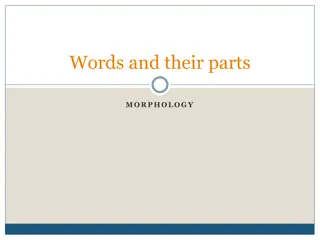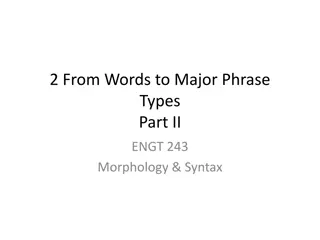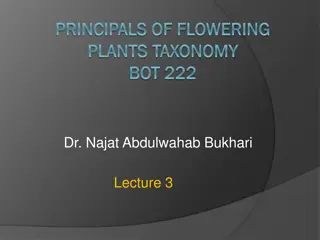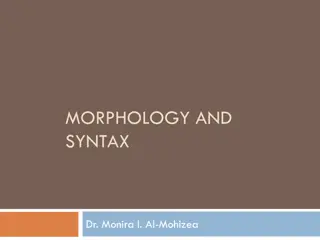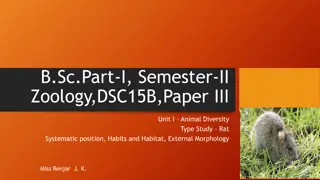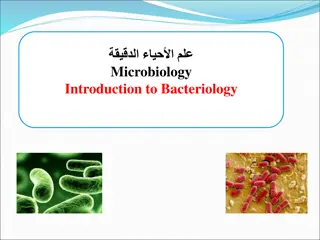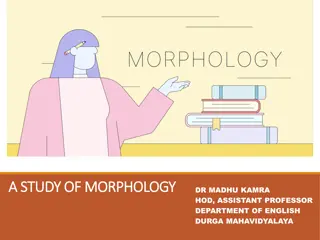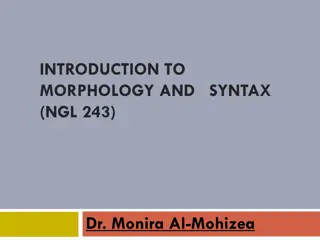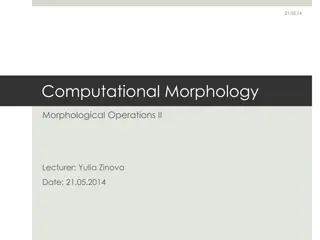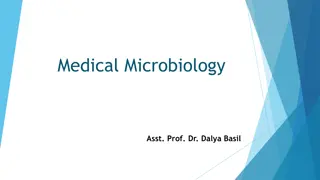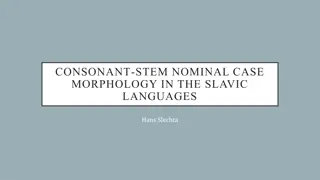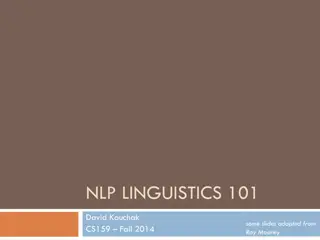Understanding Alluvial Fans: Formation, Characteristics, and Morphology
Alluvial fans are cone-shaped landforms formed by streams carrying sediments from mountains onto plains. They are prominent in arid to semi-arid regions and vary in size from a few meters to over 150 kilometers. The different zones of an alluvial fan, including the fan apex and distal fan, display d
5 views • 9 slides
Linguistics: Exploring Language Structure and Morphology
Linguistics is the scientific study of language and speech, encompassing branches like phonology, lexicology, and morphology. This field delves into the levels of language structure, such as phonological, morphological, lexical, syntactic, semantical, pragmatical, and stylistical. Scholars began inv
8 views • 7 slides
DERIVATIONAL MORPHOLOGY. PREFIXATION.
Derivational morphology in the English language involves forming new words by adding affixes to a base, resulting in derivatives or derived words. Prefixation is a productive process, especially for verb and adjective formation. Prefixes can be classified based on their meanings, such as negative, p
6 views • 6 slides
Understanding English Morphology: The Study of Words and Meaning
English Morphology delves into the structure of words, exploring morphemes as the building blocks of linguistic meaning. From free morphemes like "certain" to bound morphemes like "-ly," the discipline uncovers how words are constructed and adapted grammatically. By examining the derivational and in
0 views • 49 slides
Understanding Morphology: Word Structure and Morphemes
Morphology, a branch of linguistics, focuses on word structure by examining morphemes, which are the smallest meaningful units of language. Morphemes can be free or bound, with bound morphemes modifying the meaning of free morphemes through affixes like prefixes and suffixes. Types of affixes includ
1 views • 14 slides
Understanding Morphology in Linguistics
Morphology is a branch of linguistics that explores the structure of words in different languages. It involves dissecting words into meaningful parts called morphemes, such as prefixes and suffixes, to study their grammatical functions. Various distinctions like free vs. bound morphemes and derivati
1 views • 25 slides
Topic 7 Morphology
Delve into the realm of morphology in linguistics, exploring the internal structure of words, how words transform based on grammatical roles, and the processes of word formation through inflectional and derivational morphology. Uncover the various morphological processes and delve into the significa
0 views • 22 slides
Understanding Morphology: The Study of Words and Morphemes
Morphology is the linguistic study of how words are formed and their relationships within a language, analyzing the structure of words, morphemes, prefixes, suffixes, and more. It enriches vocabulary knowledge and aids in understanding word formations.
0 views • 16 slides
Understanding Morphology: The Study of Word Formation
Morphology is the study of how words are formed from smaller units called morphemes. This involves analyzing the structure and meaning of morphemes, whether they are free or bound. By dissecting words like "untied," we can see how morphemes contribute to linguistic patterns and communication.
0 views • 4 slides
Based on the content provided, here is the information: "Stylistic Analysis & Morphology in Visual Presentation
Explore the connection between stylistic analysis and morphology in a visual context. Dive into the intricacies of form and style through a series of slides illustrating key concepts and examples.
0 views • 20 slides
Understanding Cycas: A Detailed Look at the Morphology and Characteristics
Sixteen species of Cycas are distributed across tropical and sub-tropical regions, with India hosting six species. Cycas plants are evergreen and resemble palm trees, with unique root and stem structures. The plant body consists of an arborescent stem and distinctive leaf morphology. Cycas leaves ar
0 views • 26 slides
Overview of Bacterial Morphology and Cell Structure
This article discusses the morphology of both Gram-positive and Gram-negative bacteria, highlighting examples of different arrangements and shapes. It also explores the structure and functions of bacterial cell walls, emphasizing the role of teichoic acids in Gram-positive cell walls. Additionally,
1 views • 38 slides
Overview of Pseudomonas aeruginosa: Morphology, Identification, and Lab Diagnosis
Pseudomonas aeruginosa is a gram-negative, motile bacterium commonly found in soil, water, plants, and animals. It is a major pathogen known for causing infections in individuals with weakened immune systems. This article delves into the morphology, identification techniques, and lab diagnosis metho
0 views • 7 slides
Understanding Morphology: Roots, Affixes, and Shape of Words
This chapter delves into the study of morphology, focusing on morphemes as the building blocks of words. It discusses the characteristics of morphemes, their importance in determining word meaning, and how they contribute to the structure of complex words. By examining examples like "helpfulness" an
5 views • 38 slides
Understanding Proteus Species: Morphology, Cultural Characteristics, and Antigenic Structure
Proteus species, specifically P. mirabilis and P. vulgaris, are important opportunistic pathogens in human infections. They exhibit unique characteristics such as swarming growth on agar, gram-negative coccobacilli morphology, and distinctive antigenic structures with O and H antigens. The swarming
2 views • 25 slides
Understanding Words and Their Parts in Morphology
Explore the world of words and their parts in morphology through exercises, classifications of word classes, differentiation between content words and function words, analysis of words beginning with "b," homonyms, polysemy, and verb inflection. Delve into the various aspects of linguistics to enhan
0 views • 49 slides
Understanding Tapeworm Infections: Cestodes Overview
Cestodes, commonly known as tapeworms, are long segmented worms with distinct morphology found in the small intestine. This comprehensive guide covers Diphyllobothrium latum, Taenia saginata, their life cycles, morphology, clinical manifestations, diagnosis, and prevention strategies. Detailed infor
1 views • 20 slides
Understanding Grammar Structures in Morphology and Syntax
Exploring the relationship between words and major phrase types in English morphology and syntax, this content delves into grammar with lexical categories, constituent structures, and the formation of phrases. It highlights the importance of considering constituents and word grouping for accurate sy
0 views • 35 slides
Understanding Plant Taxonomy: A Comprehensive Overview of Flowering Plants
Plant taxonomy involves the study of various characteristics such as morphology, anatomy, photochemistry, cytology, and palynology. It plays a crucial role in the classification and understanding of plants. This content explores the principles of flowering plants, university vision and mission state
0 views • 30 slides
Understanding Morphology and Syntax in English Language
This content explores morphology and syntax in English language, covering topics like conversion, compounding, and the formation of words through various linguistic processes. It delves into examples of verb-noun conversions, productive word formation methods, and compound words. The discussion also
0 views • 27 slides
Exploring Stylistic Analysis and Morphology in Visual Presentation
Delve into the world of stylistic analysis and morphology through a series of visually engaging slides. Analyze the nuances of language structure and stylistic elements, enhancing your understanding of how they shape communication. The images provide a visual journey into the intricate details of li
0 views • 19 slides
Investigating Star Formation Histories of Early-Type Dwarf Galaxies
Delve into the star formation histories of early-type dwarf galaxies, exploring their significance as local objects and prime targets for near-field cosmology. Understand the complexities of re-ionization, age, metallicity, and morphology in the context of galaxy evolution. Uncover the relationships
0 views • 30 slides
Understanding Bacterial Colony Morphology for Microbiology Analysis
Bacterial colonial morphology plays a crucial role in identifying bacteria and fungi. This exercise focuses on recognizing the cultural characteristics of bacteria on agar plates through colony morphology. Each colony represents a genetically similar group of microorganisms derived from a single cel
1 views • 6 slides
Detailed Study of Rat's Systematic Position, Habitat, and External Morphology
Dive into the world of rats with a comprehensive exploration of their systematic position in the animal kingdom, nocturnal habits, burrow-dwelling behavior, and external morphology. Learn about the rat's reproductive patterns, average lifespan, and distinctive anatomical features from head to tail.
0 views • 8 slides
Introduction to Bacterial Cells Morphology in Microbiology
Bacteria are ubiquitous microorganisms with diverse shapes and arrangements. They exist as bacilli (rod-shaped), cocci (spherical), and spirilla (spiral-shaped). Actinomycetes are filamentous bacteria resembling molds. Understanding bacterial cell morphology is crucial in microbiology studies.
0 views • 16 slides
Language Development in Children: Morphology and Syntax Acquisition
Children's language acquisition process involves developing morphology by adding inflectional morphemes to nouns and verbs, such as "-ing" and "-s" for plurals. Overgeneralization occurs as children apply rules, leading to expressions like "foots" and "mens". Additionally, irregular plurals and poss
0 views • 13 slides
Understanding Morphology in Linguistics
Morphology in linguistics involves the study of word structure, formation, and morphemes, which are the smallest meaningful units in language. Words can be broken down into morphemes, with some being monomorphemic (e.g., "pig") and others polymorphemic (e.g., "foolishness"). The concept of morphemes
0 views • 25 slides
A Study of Morphology: Insights into Word Formation and Structure
Morphology, a field of linguistics originating from Greek words, delves into the study of word structure. It explores types of morphemes, branches of morphology, and processes like affixation and vowel change. The creation of new words and changes in existing ones through grammatical functions are a
0 views • 9 slides
Microscope Focusing and Bacteria Morphology Guide
Learn how to focus a microscope for simple staining, understand the morphology of bacteria such as cocci, bacillus, spirals, and pleomorphic shapes, and discover the process of preparing a slide smear with detailed steps and images.
0 views • 11 slides
Understanding Morphology and Syntax with Dr. Monira Al-Mohizea
Explore the fascinating realm of morphology and syntax in language with Dr. Monira Al-Mohizea's insightful guide. Learn about the internal structure of words, morphemes, and the aim of morphology to uncover subconscious knowledge. Delve into discussions on what constitutes a word and various definit
0 views • 19 slides
Morphological Operations in Computational Linguistics
Explore different morphological operations in computational linguistics, including phonological changes induced by affixation in German, subsegmental morphology in Irish, and subtractive morphology in Koasati. Transducers and examples are provided to illustrate the transformations involved in each p
0 views • 12 slides
Understanding Child Language Acquisition: Grammar Development Insights
Explore the intricacies of child language acquisition focusing on grammar development. Delve into concepts like bound morphemes, free morphemes, inflectional morphology, derivational morphology, word classes, and Roger Brown's meaning relations. Gain insights into lexical and grammatical stages of d
1 views • 11 slides
Understanding Helicobacter pylori: Morphology, Pathogenesis, and Identification
In this detailed lecture, Assistant Professor Dr. Dalya Basil discusses the characteristics, identification methods, growth characteristics, and pathogenesis of Helicobacter pylori. This spiral-shaped, gram-negative rod bacterium is associated with various gastric conditions, including gastritis, ul
1 views • 23 slides
Understanding Slavic Nominal Case Morphology & Stems
Uncover the intricacies of consonant-stem nominal case morphology in Slavic languages, from the introduction to the case system to the classification of consonant stems into major groups such as *u-stems, *n-stems, *s-stems, *nt-stems, and *r-stems. Explore the unique characteristics of *-stems, *o-
0 views • 11 slides
Overview of Myxoviruses: Classification, Morphology, and Orthomyxoviridae
Myxoviruses are a group of viruses that bind to mucin receptors on red blood cells, causing hemagglutination. They are classified into orthomyxoviridae and paramyxoviridae, with influenza viruses being major pathogens. Influenza viruses consist of three genera and have distinct morphological feature
0 views • 25 slides
Exploring NLP: Morphology, Lexicon, and Morphological Examples
Delve into the world of Natural Language Processing (NLP) through an exploration of NLP Morphology and the Lexicon. Discover the intricacies of the Mental Lexicon, Derivational Morphology, and Inflectional Morphology. Uncover examples of Reduplication, Templatic morphology, Clitics, Portmanteau word
1 views • 13 slides
Linguistics Studies at Hajee Karutha Rowther Howdia College
Explore various aspects of linguistics including phonetics, morphology, and language studies as part of the curriculum at Hajee Karutha Rowther Howdia College under the guidance of Assistant Professor Gowrisankari G. Immerse yourself in the world of languages through distinctive courses such as Nkho
0 views • 10 slides
Changes in Viscose Fabric Surface Morphology Due to Sunlight Exposure
This study explores the impact of sunlight exposure on the surface morphology of viscose fabrics. Direct exposure to sunlight for 120 days during summer showed significant changes in fiber surface depressions. The observed damage in mechanical properties correlated with alterations in surface morpho
0 views • 11 slides
Understanding Morphology: Building Blocks of Language
Morphology is the study of the internal structure of words and how they are formed from morphemes, such as stems and affixes. By analyzing morphology, we can understand how words are created and related to each other, enabling us to generalize, obtain additional information, and handle new words eff
1 views • 49 slides
Understanding Morphology in Linguistics
Morphology is a branch of linguistics that focuses on word structure and the smallest meaningful units of language known as morphemes. It delves into the decomposition of words and the classification of morphemes into bound and free categories. Bound morphemes, such as prefixes and suffixes, modify
0 views • 16 slides



